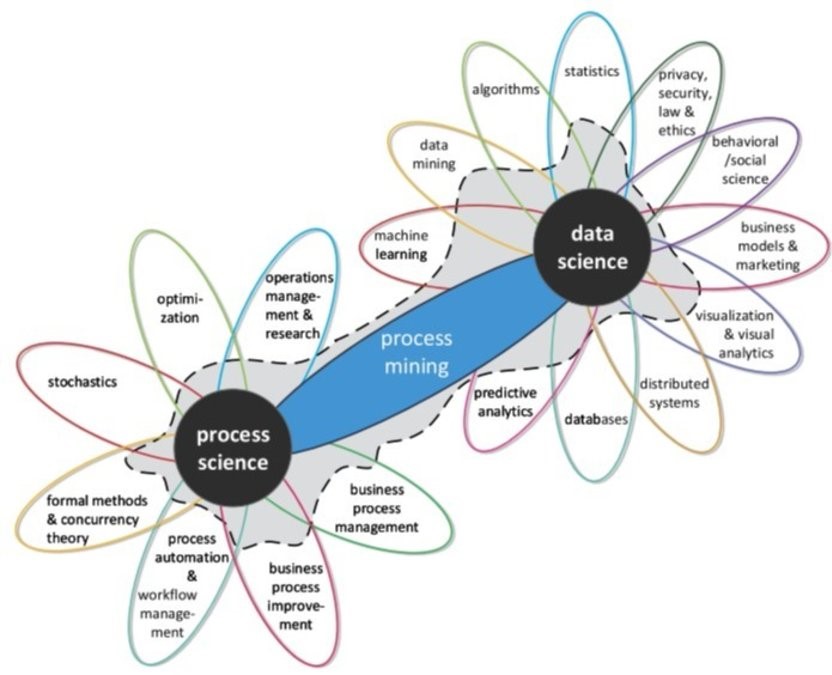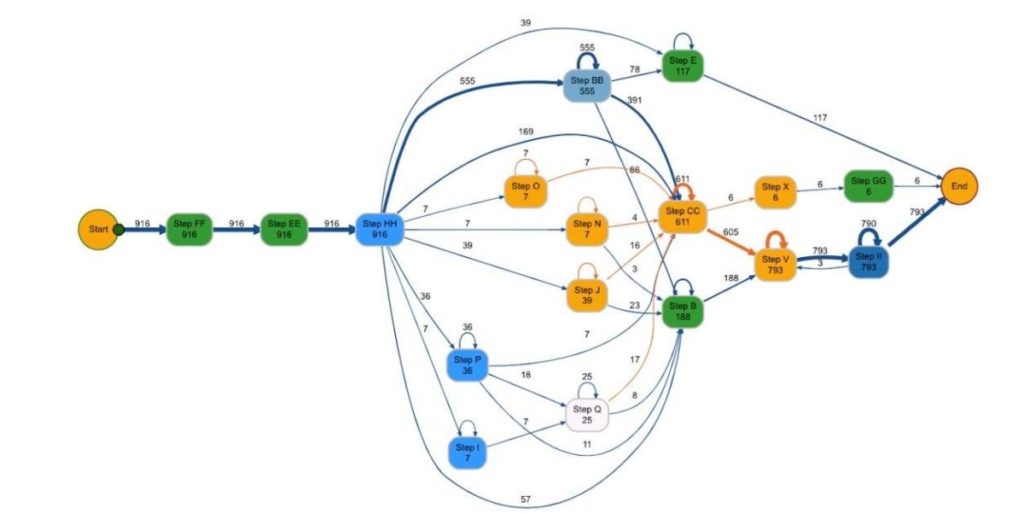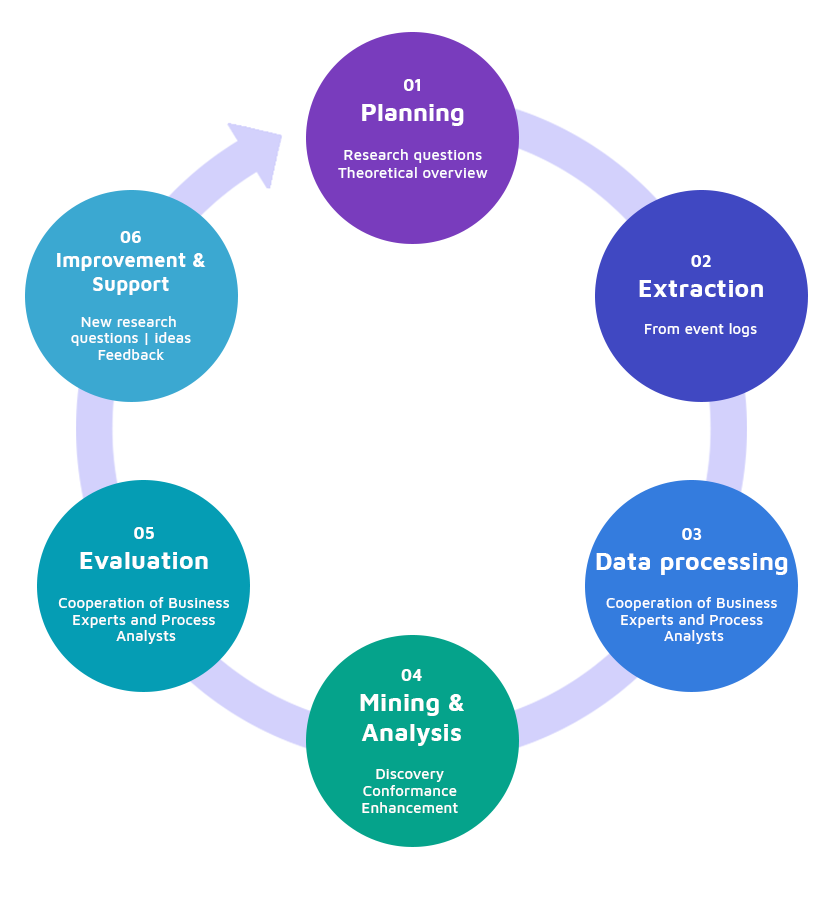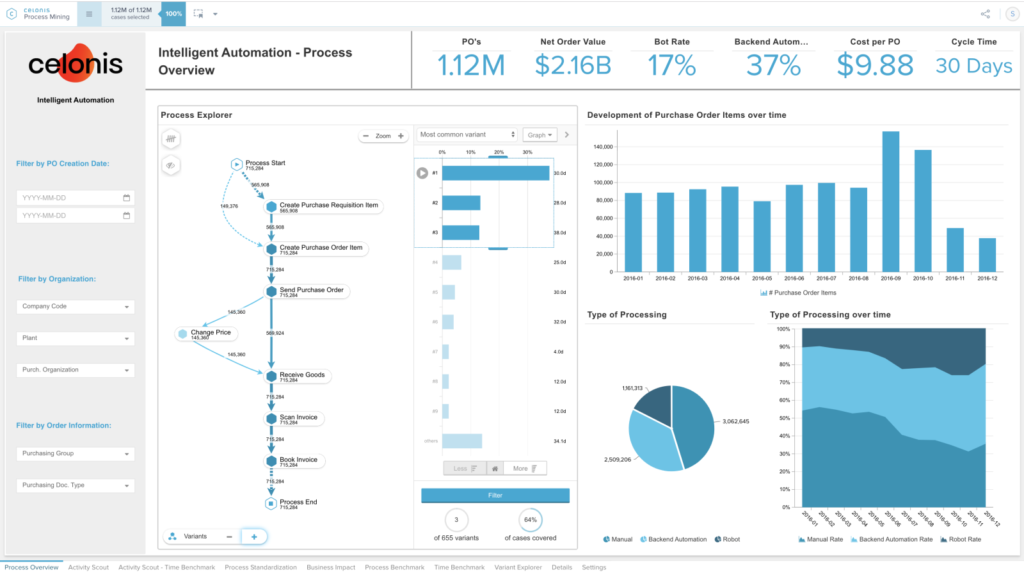The bigger the organization, the more likely it is that there are inefficiencies in their work practices. For companies that want to trim the excess and streamline for better productivity, process mining offers a lot of insight.
What is Process Mining?
There are a lot of processes within any given business, carried out by employees, staff, automated programs, visitors or others. For each instance of action, there is a digital trace left filled with data. Process mining is the act of digging up the event logs and identifying the patterns and trends within the digital traces that were left.
With so much data available, process mining has become a complex process that requires strategies, communication and a powerful process mining platform.
How Will Process Mining Benefit My Organization?
You should use process mining to optimize and automate your processes to improve efficiencies.
Process mining can be used by these groups to gain critical insights about poorly performing processes and spotting compliance violations or bottlenecks. It can be used as a monitoring process to help support employee collaboration and track employee performance.
No matter what industry you are in, there are a number of processes that your employees and customers/clients/patients perform every day. From data entry for a new lead to ringing up a sale or sending out a marketing email, every process has a certain path until completion.
In many cases, these paths are not optimized to be as efficient and effective as possible. Narrowing these gaps will often help your business offer a better experience to the customer, client or patient. In some cases, process mining is going to help find places where burdens of busywork can be removed from employees—allowing them to use their time on tasks that truly need their attention.

Process Mining Map via Celonis
Why Do You Need Process Mining?
Ideally, your processes would flow from start to finish, only including employee touch points where they are truly needed and without any back and forth. In reality, many processes get messy with unexpected complexities. Many companies don’t realize the tangled web that has become their processes, so they don’t see where these inefficiencies have taken root.
In many cases, not only do the processes get scrambled, but no one knows what those processes should look like. When it comes to process mining, the reality of the map is revealed and the process can be streamlined into a clear path forward.
It is very difficult to catch these big process issues without process mining because of many possible barriers. Some of the most common issues include:
Subjective views: Your whole team likely has a different outlook on the process. Employees will have different views of the reasoning and challenges based on their perspective. Most of the team will also have different ideas for what could solve the issues causing the poor performance in a given process.
Partial views: Many employees are going to be limited to only seeing their piece of the process. Multiple people, programs and automated actions are often included within one process. The partial view makes it difficult to get a full picture in order to spot the bottlenecks or blockages in the process.
Shifting processes: Things change all the time, which makes it harder to pinpoint consistent issues without truly tracking the process. When the process is tracked, these habitual offenders that cause inefficiencies in the process can finally be spotted.
Complexities: Many variables can throw off a given process. In most cases, there are excuses for the difficulty of the case causing the process slowdown. It is good to spot these complexities and then adjust the process to be able to handle them in the future without reverting to an inefficient process.
Visibility problems: There are parts of the process—specifically the digital activities—that can be impossible to watch from the outside and difficult to track. Without a structured monitoring method in place (process mining), you are very likely to overlook these steps of the process and only make a change if someone complains.
Unknown options: You don’t know what you don’t know, right? There is a continual push to offer options that help with every aspect of your business. Technology is changing fast and there is almost always a new and better way to do something. When you realize a point of pain, you are going to go out and search for possible solutions. Process mining helps kickstart this process by revealing issues and offering solutions to remove them from your typical workflow.

Example of Process Map via Aginic
Common Obstacles Causing Friction
While every business is different and there are a wide number of industries with unique challenges, some of the most common processes can hold points of friction that are frequently to blame for inefficiencies. According to The State of Business Execution in 2021, the top obstacles were reported as:
Accounts Payable
- Rigid systems and technologies (41%)
- Broken or inefficient processes (39%)
- Organizational silos (37%)
Accounts Receivable
- Rigid systems and technologies (42%)
- Fragmented data landscape (40%)
- Broken or inefficient processes (40%)
Procurement
- Lack of executive sponsorship (41%)
- Fragmented data landscape (41%)
- Broken or inefficient processes (39%)
Order Management
- Lack of flexible logistics networks (46%)
- Lack of visibility into processes (42%)
- Lack of visibility into supplier performance (41%)
What are the Process Mining Steps?
There are basic steps that you will follow as you start process mining. Understanding how your team will be involved can help you understand what is involved before getting started.
Collect Data
Your data engineer will need to collect the raw data from all transactional systems within your business and turn them into event logs. This might include data pulled from Salesforce, SAP, Google Sheets, Microsoft Dynamics AX, Infor, Coupa, Oracle, Trackwise, etc. Every one of these processes will leave digital footprints that can be gathered and turned into a record of completed actions occurring within your organization to create a visual map of action paths.
This first step is crucial to establish a realistic map of trends in the form of an event log. In order to reconstruct complete process flows, you will need to record the activity, time-stamp and ID (or object) for every time something happens. Any missing data could skew the big picture of the process with an incomplete perspective.
One report from Gartner warns: “Enterprises using low-quality data for process mining results in erroneous analysis and jeopardizes the overall output. EA and technology innovation leaders must manage the data quality issues to ensure data output integrity and improve decision making for process improvement and automation efforts.”
Discover Trends
The analyst is going to use the process map to find root causes for blocks or points of friction in your business workflow. This is going to go so much deeper than what an interview, strategy meeting or process mapping software could provide. It gives the analyst access to at-scale windows into your entire process.
Every process has a most efficient route from initial input to the final output. Along the way, there are also hundreds (or even thousands) of variant paths that could be caused by errors or inefficiencies. The point of process mining is to find the primary route of the most efficient and effective series of actions. Achieving this streamlined route will become the goal going forward.
During this second step of the process mining evaluation, the analyst will need to pinpoint the points where processes are inefficient or cause friction. At each point of friction, the analyst needs to also determine the root cause of that hold-up and the optimal pathways that would be ideal alternatives. All deviations should be considered to help catch potential process missteps in the future.
The analyst might even suggest business outcomes that will be impacted by these changes. They can record the current circumstances and note which corrective actions could be taken to improve those outcomes.
Enhance Processes
Business users should look at the process to proactively remove friction and automate tasks. Artificial intelligence (AI) and machine learning can often be used here to cut redundancies and reduce busywork for improved productivity.
Shifting processes to include more automation in the right areas should help reduce human error while freeing up employees to do other tasks. In some cases, the steps to enhance your processes are going to reduce the need for direct oversight and improve the standardization for consistent results. At every point, enhancement should bring:
- Clarity
- Acceleration
- Improved outcomes
- Alignment
Monitor Change
The employees and customers participating in any business processes are essentially in a continual place of testing the process. Executives and managers will need to monitor process performance and be aware of points that may need reworking. This means that process mining goals and outcomes stay in a state of improvement. The discovery, monitoring and strategy improvement are never-ending parts of keeping the processes efficient.
The executive leadership and management need to establish KPIs to ensure a serious effort is being made to course-correct as the process mining strategy has recommended. Without a focused effort, it is impossible to know if the strategy is working to improve efficiency, or if the processes still need to be reworked.
Teams have to be held accountable to meet these KPIs that line up with the process mining findings. Corporate leadership should have access to real-time monitoring tools to support course correcting. Engagement needs to occur across all departments and teams in order to create organization-wide change.
Conformance checking can help management assess how well teams are following the determined path for the highest efficiency. Tracking conformance can help pinpoint any new points of friction and offer immediate adjustments to keep processes optimized. This allows the team effort to be as transparent as possible, inviting governance in as a supportive element rather than feeling penalized.
The right process mining platform is going to be an important part of organizing the data, spotting the patterns, understanding the path potentials and monitoring compliance. Before choosing the right platform, you can get started by outlining your strategy and preparing for the process mining change,
How to Start Process Mining
To get started, there are three major strategic components you should establish. These help your process mining efforts have a higher chance of success by focusing on prepping your team and organizing your approach.
Create KPIs to Meet Goals
You are going to want to have an agile approach to change when it comes to process mining. The first changes should be made in the areas where the friction is having the largest impact on your business and is the easiest to change. The goal is to start small and scale larger, working until all processes are as optimized as possible. But, some processes are going to have a much larger impact on your sales, your business reputation and your customer.
For every goal, you need to create KPIs (key performance indicators). In order to find success, you need to be very clear about what you are changing and which parts of the process are causing friction.
The KPI objectives can be set before your process mining because you probably already know some of your biggest organizational pains. Then, as the process mining efforts uncover the biggest areas of lag, you will be able to set the performance indicators to directly address those issues. This is going to make those goals really powerful.
There is going to be a fine line between micromanaging employees and letting consistent friction occur to slow down key processes. There are also going to be some counterintuitive things that you should consider for improving processes—like giving employees regular breaks to get up and move around to improve their focus and productivity.
Establish Your Team
You will need everyone on board to make these changes because you will be examining every aspect of every job. If you are unable to clearly communicate your intent and get people motivated to participate, you may end up with unconscious resistance. People rarely like to change for the sake of change and sometimes these efforts just sound like extra work. It is important to also communicate areas where employees will have busywork lifted from their to-do piles so they can focus on areas of their job where they are truly needed most.
You will have to be clear on the roles that staff and managers play in this process. As KPIs are established, tasks and process changes should be given directly to the teams that need to implement them.
In most cases, it will help to get input from the lower-tier employees. By making them part of the process, it will be easier to make them part of the solution. Find out where they feel they are most slowed down or hampered in doing their jobs. Addressing their pain points will make them more interested in addressing pain points they might be causing.
Communicate for Success
Teams have to be accountable to make these changes, and communication needs to be clear to give them the best chance for success.
- Always clarify start dates and end dates.
- Put process changes in writing—even just a staff memo.
- Clarify methods for checking success (KPIs) and compliance
- Communicate the overarching goal that caused the change
- Express positive perspectives and gratitude for team players
It can be difficult to communicate the positive side of process mining. If everything starts to sound like doom and gloom (as if employees are being evaluated and will need to “comply” with changing requirements), then you may have frustrated or stressed employees.
Communicating a positive perspective of change is going to be a key part of keeping employees on board and ready to implement these shifts.
Also, remember that in some cases, process mining may find there is an issue that is largely user error on the part of the customer or client. So, there will be many times where “training” clients—or communicating to the customer—is a key part of improving the process.

Example of Process Mining Steps via Lingraro Group
How to Start Task Mining
Part of process mining can include dialing in on the information that tells you how your people are performing. Task mining takes user interaction data to analyze how people are getting their work done and how their activities could be improved. This can be beneficial since it will:
- Uncover inefficiencies occurring outside of automated systems
- Examine and measure workplace productivity for optimal results
- Dive best-actions across the teams to boost manual processes
What is Task Mining?
Task mining moves past the business data to examine the desktop data. Business data is the time-stamped transactional logs that reveal steps employees are taking during their processes. You will be able to see everything that happened and when it occurred.
Task mining delves into desktop data to look at the things between these steps that make them happen. If the business data gives you the timeline of when a purchase order was created, approved, fulfilled and dispatched, then the desktop data will tell you what is done to make those steps happen. You will examine what employees are doing to approve the PO, or how long it takes to match invoices to the receipts.
You can see where people are deviating from the normal process and where the process is just sluggish to start with.
How Task Mining is Done
In order to collect the actions, you need to focus your mining on the systems that your users are working with. This is how you can start task managing.
Capture Desktop Activity: Grab time-stamped data from the desktop, like clicking, scrolling and all user activity.
Add Business Context: You can use OCR technology (Optical Character Recognition) to see what your users are saying and get a better understanding of what they are doing.
Group Tasks and Activities: Clump together the same actions using Natural Language Processing (NPL) technology to get a better picture of how actions typically take place. This might include groups like “proofing and approving a PO” or “searching for buyer leads on LinkedIn.”
Align with Business Outcomes: You will then align the tasks to the specific business outcomes they are impacting to get a better feel for how they are impacting the bottom line.
Optimize Execution and Performance: Finally, you will leverage task mining data with a strategy to improve these processes and cut out the unnecessary steps. You should start with the activities that have the biggest impact on your business outcomes.
The Challenges of Task Mining
Process mining is complicated and task mining may be even more so. You are looking at how people choose to approach programs and workflow—and there are an infinite number of ways to do it. It will require cutting through the noise to find which actions are really impacting execution.
Wil van der Aalst is a pioneer and the father of process mining with over 200 articles published in scientific journals and contributions to over 500 book publications. He explains:
“People, no matter which industry, company, or department they work in, have a “mind of their own.” They don’t always follow the prescribed path, policy, or work instruction. They take manual workarounds, send invoices back and forth between departments, buy without a PO, pay invoices twice. It’s a nightmare.
So I’ve come to the hard realization that my fellow academics and I just had a very naive idea of how standard processes were being executed. Process steps are nonlinear, unpredictable, and sometimes even change from one employee to another. There simply wasn’t just one happy path.”
Choosing a Process Mining Platform
As with many things these days, this change is best made with a platform in place to help organize and monitor your efforts. It would be really difficult to collect and manage the data for process mining on your own. When choosing your platform, there are some key benefits you should be looking for.
Easy Integration
Of course, your process mining platform is going to have to work with the systems you have in place. It should be already prepared to integrate with Salesforce, Microsoft, Google and other transactional systems you are using. You shouldn’t need to write code to get your systems to connect for a complete overview of activity logs and process paths.
Pre-Established Analyses
You want an out-of-the-box solution that is ready to go and provides immediate analysis. When your platform is already prepared with analysis capabilities for common processes in your business, then you will be able to examine friction and implement change much faster.
User-Friendly Interface
Tools can be confusing and complex if they aren’t well-designed. The dashboard and capabilities of the process mining platform should be largely intuitive. You should have control over creating workflows, building assessments, exploring your organizational processes and setting goals within the platform.
Action-Based Tools
Discovery and analysis aren’t the only steps in process mining. Your platform should also include tools to help you turn your findings into actions. You should be able to set alerts, establish KPIs and monitor changes.
Training Center
Offering training resources to your teams will help speed up the process mining changes you wish to implement. Your platform should enable you to utilize training that helps your team get results. The platform may even be able to offer examples of how other companies have made changes to improve the same processes you are looking to optimize.
Industry Compliance
Not all businesses are going to have the same needs, goals or processes. Your process mining software should be familiar with your industry. Banking, healthcare, insurance and legal are all going to have different privacy concerns than retail and SaaS. Every industry is going to have different approaches for sales, account management and customer retention. Some may have unique processes, like client consultations, policy underwriting, background checks or complex data entry. Check to ensure your platform is prepared to handle the kind of business or organization you are running.
Performance Capabilities
Will your platform be able to handle several different users or large data sets? You need to choose a platform that fits the needs of your process mining efforts. Some platforms are going to be cloud-based, while others are hybrid or on-site. Some will let you define admin users and set up user roles for those who will be accessing information without authorization to make changes.
Some of the top names for process mining platforms include:
- Celonis
- Nintex Promapp
- myInvenio
- Signavio Process Intelligence
- IBM BlueworksLive
- UiPath Process Mining
- MySmartAutomation

Example of Process Mining Analytics Dashboard via Celonis
Perfecting Execution Through Process Mining
It is going to be very difficult to be a top-performing company if your processes are sluggish. In order to offer a stellar experience to customers, patients or clients, businesses have to keep evaluating and perfecting execution at every turn.
With so many companies pursuing digital migration, this is more important now than ever before. Companies are often spread across multiple platforms and channels—there are so many opportunities for gaps to form in the process. When you are spending a large chunk of your budget on areas like e-commerce, you don’t want to maintain costly efficiency issues.
Use process mining to find gaps in the path and transform business operations into a simplified route that streamlines your efforts.

